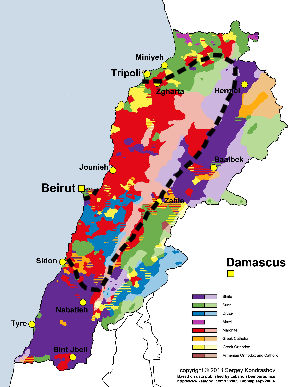Greater Lebanon
The term, in French "Le Grand Liban", was first used by the Lebanese intellectuals Bulus Nujaym and Albert Naccache, during the buildup to the 1919 Paris Peace Conference.[6] The quest for the annexation of agricultural lands in the Bekaa and Akkar was fueled by existential fears following the death of nearly half of the Mount Lebanon Mutasarrifate population in the Great Famine; the Maronite church and the secular leaders sought a state that could better provide for its people.On instructions from the French government, General Gouraud has proclaimed at Zahle's Grand Kadri Hotel, the incorporation into Lebanon of the territory that extends up to the summit of the Anti-Lebanon range and of Hermon.During World War II when the Vichy government assumed power over French territory in 1940, General Henri Fernand Dentz was appointed as high commissioner of Lebanon.In the face of intense British pressure and protests by Lebanese nationalists, the French reluctantly released the government officials on 22 November 1943, and accepted the independence of Lebanon.A custom of selecting major political officers, as well as top ranks within the public administration, according to the proportion of the principal sects in the population was strengthened during this period.This practice increased sectarian tension by providing excessive power to the Maronite president (such as the ability to choose the prime minister), and hindered the formation of a Lebanese national identity.To break the deadlock, some deputies suggested Shaykh Muhammad al Jisr, who was chairman of the Council of Ministers and the Muslim leader of Tripoli, as a compromise candidate.Dissatisfied with Ponsot's conduct, the French authorities replaced him with Count Damien de Martel, who, on 30 January 1934, appointed Habib Pacha Es-Saad as president for a one-year term (later extended for an additional year).





Emblem (1925–40)Mandate for Syria and the LebanonMandateFranceBeirutArabicFrenchEnglishArmenianChristianityHigh CommissionerHenri GouraudPresidentCharles DebbasÉmile EddéPrime MinisterAuguste Adib PachaRiad Al SolhInterwar periodConstitutionIndependence declaredSyrian poundLebanese poundOccupied Enemy Territory AdministrationLebanonromanizedLeague of Nations MandateOttoman EmpireTreaty of SèvresPalestineGeneral GouraudterritoryFrench flagLebanese cedarMount Lebanon MutasarrifateOttomanTripoliMutasarrifateRèglement Organique1919 Paris Peace ConferencePine ResidenceMaronitePatriarchElias Peter HoayekParis Peace ConferenceGreat FamineBeirut VilayetSyria VilayetBaalbekRashayaHasbayaFrench Mandate for Syria and the LebanonArab Kingdom of Syrialatter's defeat in July 1920Battle of MaysalunAlexandre MillerandAnti-LebanonHermonSyria–Lebanon campaignWorld War IIVichy governmentHenri Fernand DentzAlfred NaqqacheNazi Germanysent its army into Syria and LebanonCharles de GaulleGeorges CatrouxLevant Crisisindependence of LebanonUnited NationsLebanese constitutionFrench Third RepublicbicameralHistory of LebanonTimelineAncientCanaanPhoeniciaAmurru kingdomEgyptian ruleHittite ruleAssyrian ruleBabylonian ruleHellenistic ruleRoman ruleSassanid interludeRashidun CaliphateUmayyad CaliphateAbbasid CaliphateTulunidsHamdanid dynastyFatimid CaliphateIkhshidid dynastyMirdasid dynastySeljuk Empire County of Tripoli Kingdom of JerusalemZengid dynasty Mamluk SultanateAssafsMa'anidsHarfushidsOttoman rule Emirate of Mount Lebanon Tripoli Eyalet Sidon Eyalet ShihabsEl Assaad FamilyDouble Qaim-Maqamate of Mount LebanonAllied administrationRepublic of Lebanon1958 Lebanon crisisChehabist eraPalestinian insurgencyLebanese Civil WarAftermathIsraeli occupation of Southern LebanonSyrian occupation of LebanonCedar Revolution2006 July War2006–08 political protests2007 North Lebanon conflict2008 conflict in LebanonSyrian Civil War spillover in LebanonLebanese presidential crisisMaritime boundary dispute